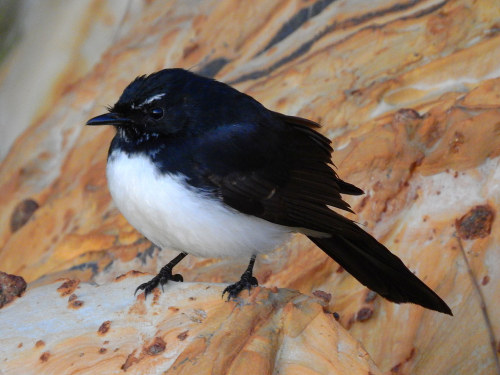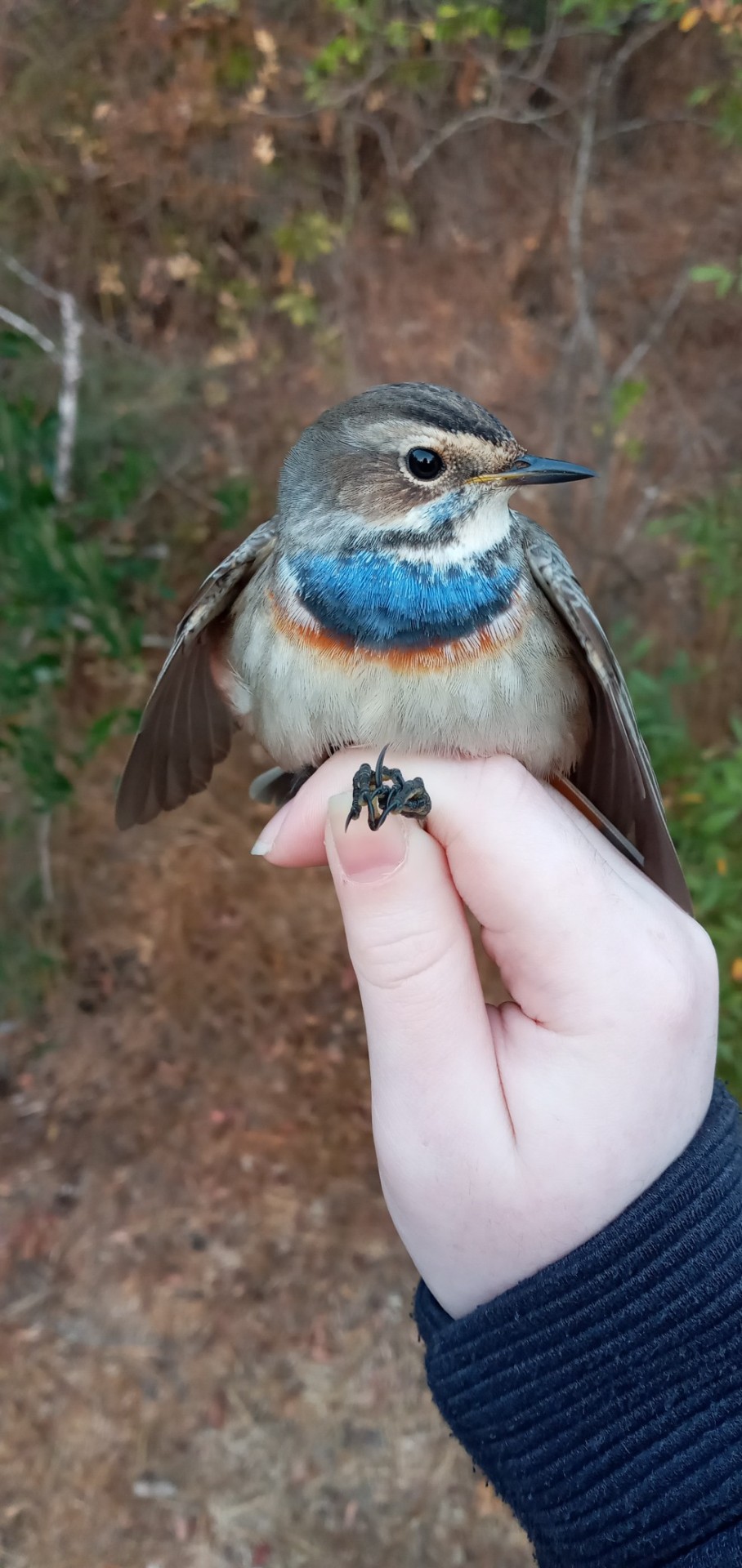Horned Sungem (Heliactin Bilophus)

Horned Sungem (Heliactin bilophus)
© Carlos Goulart
More Posts from Eggxecutive-dysfunction and Others

Willie-wagtail (Rhipidura leucophrys)
© Bill (OFF and ON)







Bluethroat (Luscinia svecica), male, from a banding. Jerusalem Bird Observatory (JBO). 21.10.21

The Magnetic Field of the Whirlpool Galaxy : Do magnetic fields always flow along spiral arms? Our face-on view of the Whirlpool Galaxy (M51) allows a spectacularly clear view of the spiral wave pattern in a disk-shaped galaxy. When observed with a radio telescope, the magnetic field appears to trace the arms’ curvature. However, with NASA’s flying Stratospheric Observatory for Infrared Astronomy (SOFIA) observatory, the magnetic field at the outer edge of M51’s disk appears to weave across the arms instead. Magnetic fields are inferred by grains of dust aligning in one direction and acting like polaroid glasses on infrared light. In the featured image, the field orientations determined from this polarized light are algorithmically connected, creating streamlines. Possibly the gravitational tug of the companion galaxy, at the top of the frame, on the dusty gas of the reddish star-forming regions, visible in the Hubble Space Telescope image, enhances turbulence – stirring the dust and lines to produce the unexpected field pattern of the outer arms. via NASA
I had a bit of a technical mishap yesterday and was not able to work on photos. Today, I will use the sunny weather and mild temperatures to close the pond for the season and set up the heated bath, so the livestream will be off for a bit. I hope everyone has a wonderful Halloween! Count Grackula is already excited 😎 New photos tomorrow evening.








Playtime for young kea birds! There’s a benefit to this apparently carefree behavior. It helps establish long-lasting relationships between the youngsters and even diffuses tension. David Attenborough | BBC Earth

Galaxies and the South Celestial Pole : The South Celestial Pole is easy to spot in star trail images of the southern sky. The extension of Earth’s axis of rotation to the south, it’s at the center of all the southern star trail arcs. In this starry panorama streching about 60 degrees across deep southern skies the South Celestial Pole is somewhere near the middle though, flanked by bright galaxies and southern celestial gems. Across the top of the frame are the stars and nebulae along the plane of our own Milky Way Galaxy. Gamma Crucis, a yellowish giant star heads the Southern Cross near top center, with the dark expanse of the Coalsack nebula tucked under the cross arm on the left. Eta Carinae and the reddish glow of the Great Carina Nebula shine along the galactic plane near the right edge. At the bottom are the Large and Small Magellanic clouds, external galaxies in their own right and satellites of the mighty Milky Way. A line from Gamma Crucis through the blue star at the bottom of the southern cross, Alpha Crucis, points toward the South Celestial Pole, but where exactly is it? Just look for south pole star Sigma Octantis. Analog to Polaris the north pole star, Sigma Octantis is little over one degree fom the the South Celestial pole. via NASA
-
 jo526 reblogged this · 2 years ago
jo526 reblogged this · 2 years ago -
 iicraft505 reblogged this · 3 years ago
iicraft505 reblogged this · 3 years ago -
 iicraft505 liked this · 3 years ago
iicraft505 liked this · 3 years ago -
 smartcookieproductions liked this · 3 years ago
smartcookieproductions liked this · 3 years ago -
 destroyscythe-heck reblogged this · 3 years ago
destroyscythe-heck reblogged this · 3 years ago -
 mitashade liked this · 3 years ago
mitashade liked this · 3 years ago -
 evilpetgirlwizard liked this · 3 years ago
evilpetgirlwizard liked this · 3 years ago -
 bombshelllblonde reblogged this · 3 years ago
bombshelllblonde reblogged this · 3 years ago -
 peanutbutter-nutella reblogged this · 3 years ago
peanutbutter-nutella reblogged this · 3 years ago -
 peanutbutter-nutella liked this · 3 years ago
peanutbutter-nutella liked this · 3 years ago -
 vivi-mire reblogged this · 3 years ago
vivi-mire reblogged this · 3 years ago -
 skadren reblogged this · 3 years ago
skadren reblogged this · 3 years ago -
 bodhishadow reblogged this · 3 years ago
bodhishadow reblogged this · 3 years ago -
 impertinentfiend reblogged this · 3 years ago
impertinentfiend reblogged this · 3 years ago -
 impertinentfiend liked this · 3 years ago
impertinentfiend liked this · 3 years ago -
 wilbursasthma liked this · 3 years ago
wilbursasthma liked this · 3 years ago -
 so-i-am-kinda-funny-tm liked this · 3 years ago
so-i-am-kinda-funny-tm liked this · 3 years ago -
 marshmeleesblog liked this · 3 years ago
marshmeleesblog liked this · 3 years ago -
 ilovechristopheralexandershaw liked this · 3 years ago
ilovechristopheralexandershaw liked this · 3 years ago -
 pitchblackagony liked this · 3 years ago
pitchblackagony liked this · 3 years ago -
 energywaste liked this · 3 years ago
energywaste liked this · 3 years ago -
 charliechangeling reblogged this · 3 years ago
charliechangeling reblogged this · 3 years ago -
 lukasspookas liked this · 3 years ago
lukasspookas liked this · 3 years ago -
 libelelle liked this · 3 years ago
libelelle liked this · 3 years ago -
 novagoatia liked this · 3 years ago
novagoatia liked this · 3 years ago -
 charliechangeling liked this · 3 years ago
charliechangeling liked this · 3 years ago -
 meoworm liked this · 3 years ago
meoworm liked this · 3 years ago -
 syzy9y reblogged this · 3 years ago
syzy9y reblogged this · 3 years ago -
 homeplanets reblogged this · 3 years ago
homeplanets reblogged this · 3 years ago -
 thearspoetica liked this · 3 years ago
thearspoetica liked this · 3 years ago -
 verycroissantcreatoralmond liked this · 3 years ago
verycroissantcreatoralmond liked this · 3 years ago -
 a-blue-muse reblogged this · 3 years ago
a-blue-muse reblogged this · 3 years ago -
 licos-accidental-main-lol liked this · 3 years ago
licos-accidental-main-lol liked this · 3 years ago -
 satvrnales liked this · 3 years ago
satvrnales liked this · 3 years ago -
 wxrumble liked this · 3 years ago
wxrumble liked this · 3 years ago -
 beautifulbrokenglassheart liked this · 3 years ago
beautifulbrokenglassheart liked this · 3 years ago -
 esleep reblogged this · 3 years ago
esleep reblogged this · 3 years ago -
 esleep liked this · 3 years ago
esleep liked this · 3 years ago






